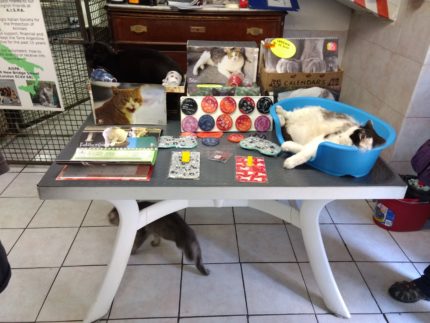 It is fitting that my first post from Rome should be about the cat sanctuary at Largo Argentina. Last year I never managed to visit the sanctuary itself because I kept missing the open hours. Still, the remains of Pompey’s Theater and four other Republican-era sacred sites are liberally peppered with their most famous denizens, one of whom stared at you with supreme disinterest from yesterday’s post.
It is fitting that my first post from Rome should be about the cat sanctuary at Largo Argentina. Last year I never managed to visit the sanctuary itself because I kept missing the open hours. Still, the remains of Pompey’s Theater and four other Republican-era sacred sites are liberally peppered with their most famous denizens, one of whom stared at you with supreme disinterest from yesterday’s post.
In 2012, the Torre Argentina Roman Cat Sanctuary was threatened with eviction by the Superintendency for the Archaeological Heritage of Rome. Officials had grandiose plans to improve the site for tourism because it had made some (largely spurious) press about the supposed discovery of the exact spot where Julius Caesar was assassinated there. The sanctuary was deemed “a health hazard” even though it is kept scrupulously clean to prevent the spread of communicable diseases and the authorities indulged in a fancy that the space it occupies, basically a moist cave underneath the tram tracks, should be excavated and opened to visitors hungry for more of those sweet vaguely Caesar-associated remains.
At the time, the sanctuary reached out to supporters to write letters and donate funds to keep the doors open. Nobody else is doing anything about the feral and stray pet population, while they have spayed and neutered more than 30,000 cats on a shoestring budget. The hope was they could stave off the eviction and become officially recognized by the city instead of having to effectively squat at the site where the cats already live.
 I wasn’t able to get a follow-up on the story. I saw last year that they had not been evicted and thought they might even have gotten that longed-for official recognition because of the signs warning tourists not to feed the cats which are cared for by the sanctuary. Now that I’ve been there and spoken to the volunteers, I can reveal the outcome of the 2012 brouhaha: not a damn thing. As so often happens, the big plans fell through because the Superintendency is always strapped for cash and can barely manage to maintain the archaeological patrimony that is already a big draw for tourist money. They have not received official recognition. The current mayor of Rome has no interest whatsoever in the sanctuary, and that’s just how they like it. Being ignored by the authorities works just fine for them because the status quo is way better than threatened crackdowns or failed build-ups. Meanwhile, they tell me, firemen, municipal police, Carabinieri, etc. bring cats to them all the time so they’re official in practice if not in theory.
I wasn’t able to get a follow-up on the story. I saw last year that they had not been evicted and thought they might even have gotten that longed-for official recognition because of the signs warning tourists not to feed the cats which are cared for by the sanctuary. Now that I’ve been there and spoken to the volunteers, I can reveal the outcome of the 2012 brouhaha: not a damn thing. As so often happens, the big plans fell through because the Superintendency is always strapped for cash and can barely manage to maintain the archaeological patrimony that is already a big draw for tourist money. They have not received official recognition. The current mayor of Rome has no interest whatsoever in the sanctuary, and that’s just how they like it. Being ignored by the authorities works just fine for them because the status quo is way better than threatened crackdowns or failed build-ups. Meanwhile, they tell me, firemen, municipal police, Carabinieri, etc. bring cats to them all the time so they’re official in practice if not in theory.
The volunteers are dedicated, warm, welcoming and so enthusiastic about their charges. They made a point of taking us into the back room where the disabled cats live in safety and comfort without having to cope with the dangers of the Roman city center. Blindness is very common in the stray cat population here because most of them are born to stray mothers and quickly get eye infections when they’re too young to recover from them.
The sanctuary is always in need of funds to support the tireless work they do. I promised I would promote their Distance Adoption program which gives you all the warm fuzzy feelings of saving a cat that is probably a little too wonky to be adopted plus the bragging rights of having rescued a cat who whiles away the hours sprawled over the place where Julius Caesar was stabbed.
I will leave you with a view of the entrance to the sanctuary adorned by Quinoa, their cat of the month. He enjoys sleeping, being petted while sleeping and taking occasional breaks from sleeping to snack.

Under the table is a three-legged furry blur named Pioppo who is available for distance adoption, just fyi.
Sorry, not a fan of cats (or any other animal thrown upon us). I know many are. But I, for one, would not visit them just for that reason. Others might visit because the cats are there, but not for a historical reason. I think it is best to separate the two so all can visit the area they enjoy most.
Heather, …HIC SUNT LEONES !!! >°°<
Its actually the other way round: Its mainly the cats themselves that have an interest in sacred sites, and the ones with cats have a special allure to them.
The cats, of course, have indeed no problem when other sites are visited.
Already 2500 years ago, however, it has been clearly pointed out that:
————–
“About these animals there is a custom of this kind: Both men and women, provide the food for each kind of beast separately, and their office goes down from father to son; When they make a vow to the god to whom the animal belongs, they shave the head of their children either the whole or the half or the third part of it, and then set the hair in the balance against silver, and whatever it weighs, this the man gives to the person who provides for the animals, and she cuts up fish of equal value and gives it for food to the animals.”
‘Transliterated Greek’: nomos de esti peri tun theriun ude exun. meledunoi apodedexatai teis trofeis xuris ekastun, tun pais para patros ekdeketai ten timen. [4] oi de en teisi polisi ekastoi eyxas tasde sfi apoteleoysi. eyxomenoi tui theui tou an ei to therion, xyruntes tun paidiun e pasan ten kefalen e to emisy e to triton meros teis kefaleis, istasi stathmui pros argurion tas trixas. to d’ an elkusei, touto tei meledunui tun theriun didoi, e de ant’ aytou tamnoysa ixthus parexei boren toisi therioisi. [5] trofe men de aytoisi toiaute apodedektai….
:hattip:
I have to admit that I’m not a fan of the cats being there, either. Nothing against the cats (although I’ll take a dog over a cat any day) – I just don’t want to see cats running around all over historical sites.
In my mind, it’s disrespectful to the history of the site, which to me is like one big ancient artifact. It would be like letting hamsters burrow into Ramses’ mummy and make it a home because “they’re just so darned cute”.
I’m all for animal care, and having a sanctuary for these cats, but not where they’re climbing all over the site (and doing everything else they do all over it).
One of my favorite sites in Rome! My art history students always enjoy hearing about the cats and the humans who care for them. Thanks for covering it again!
One of my favorite sites in Rome! My art history students always enjoy hearing about the cats and the humans who care for them. Thanks for covering it again!
In a way it is kind of sad how modern education alienates the individual from the world. The cats are there because they have always been there and, like the Serengeti, people also go to view the animals.